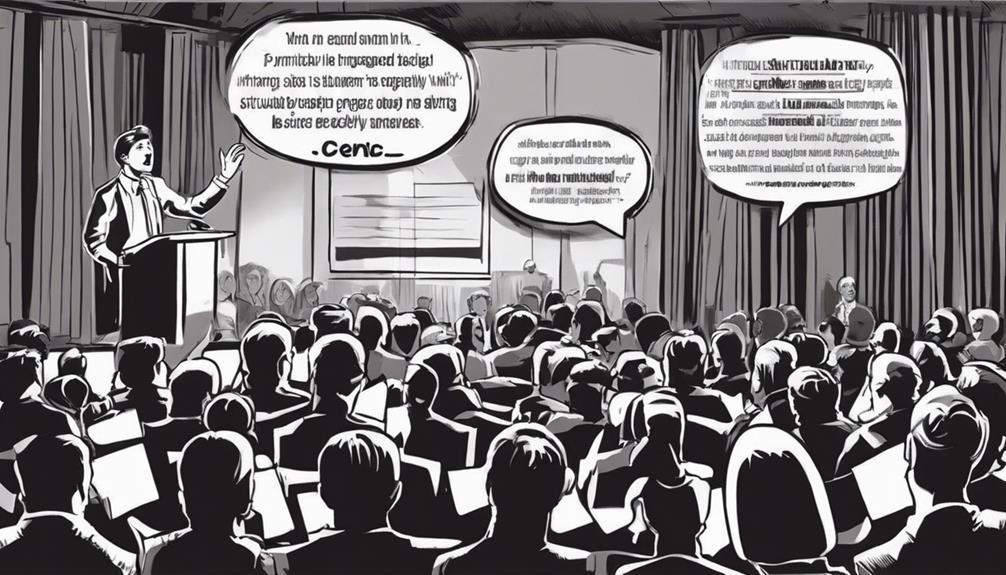Parenting Tips
Navigating Effective Communication With Teenagers
Wondering how to connect with your teenager? Explore effective communication strategies that build trust and promote well-being.

Talking to teenagers takes **active listening**, **trust-building**, and **open chats** to keep them feeling good and safe. By really **listening**, parents can show they care, build trust, and make it okay to talk about anything. Trust means being kind, not judging, and respecting their space. Good chats help them feel strong, solve problems, and stay happy. Knowing the impact on mental health helps and cuts down on fights. It’s key to keep cool and encourage open talks. Find more tips to talk better and connect stronger with your teens. Discover more [here](< Active listening plays a pivotal role in fostering effective communication between parents and teenagers. By actively listening, individuals show genuine interest in what the other person is saying. This involves giving full attention, clarifying points for better understanding, and reflecting back to demonstrate comprehension. When parents actively listen to their teenagers, it creates a safe space for open dialogue and encourages the sharing of thoughts and feelings. This practice helps build trust and understanding between both parties, leading to stronger relationships and improved communication. Active listening also allows parents to validate their teenagers' emotions, which can help in addressing sensitive topics and resolving conflicts. Fostering trust and understanding is foundational for establishing a strong bond between parents and teenagers. Building this connection requires active listening, empathy, and open communication. Parents should make an effort to create a safe environment where teenagers feel comfortable sharing their thoughts and experiences. Validating their emotions and being non-judgmental can help build trust. Encouraging open dialogues and respecting boundaries are essential aspects of nurturing understanding. To illustrate this concept further, here is a table highlighting key strategies for building trust and understanding: Promoting well-being through effective communication is crucial for nurturing positive relationships and emotional resilience in teenagers. By fostering open and honest dialogues, parents can create a supportive environment that encourages teenagers to express themselves freely. Genuine interest in their lives and emotions helps strengthen the parent-teen bond, leading to improved emotional well-being and problem-solving skills. Ongoing communication equips both parties to handle challenges collaboratively, reducing misunderstandings and conflicts. Encouraging self-confidence, self-awareness, and academic performance, effective communication plays an essential role in promoting overall well-being. By validating emotions, offering support without judgment, and maintaining a safe space for open expression, parents can greatly impact their teenagers' mental health and resilience. Creating a safe and open environment for dialogue is essential for building healthy relationships between parents and teenagers. Mutual respect, cooperation, and understanding form the foundation of strong parent-teen relationships. It's important to create a safe space where both parties feel comfortable expressing themselves. Asking open-ended questions and practicing empathetic listening can foster a deeper connection. Addressing the challenges teenagers face in society shows understanding and support. Maintaining a calm and respectful tone during conversations is critical to avoid misunderstandings. Acknowledging the importance of effective communication on mental health is crucial in nurturing positive outcomes for both parents and teenagers. Open and honest dialogues can decrease feelings of isolation, enhance coping mechanisms, and reduce the risk of depression and anxiety. By promoting a sense of belonging and support, effective communication encourages seeking help when needed. Improving emotional well-being, problem-solving skills, self-confidence, and self-awareness are additional benefits. Communication also plays a role in reducing misunderstandings, conflicts, and improving academic performance and social interactions. Building trust, understanding perspectives, and strengthening relationships through communication contribute greatly to the mental health of both parents and teenagers. It's essential to maintain open channels of communication to foster a supportive environment and prevent emotional distance. Encouraging teenagers to openly share their thoughts and feelings fosters a strong foundation for effective communication. Parents can promote open dialogues by actively listening to their teens, showing empathy, and creating a safe space free of judgment. Validating their emotions and experiences helps build trust and encourages honesty. Asking open-ended questions and being genuinely interested in their lives can lead to more meaningful conversations. It's important to respect their boundaries and offer support without trying to control the conversation. By nurturing an environment where teens feel comfortable expressing themselves, parents can strengthen their bond and foster a relationship built on trust and understanding. To foster resilience and connection in teenagers, active listening and validation of their experiences play an essential role in building trust and understanding. By actively engaging with teens and acknowledging their feelings, parents can create a supportive environment that promotes emotional strength and bonding. Here is a table to highlight key strategies for nurturing resilience and connection: Utilizing these approaches can help parents establish meaningful connections with their teenagers, fostering resilience and promoting healthy relationships. When discussing sensitive topics, parents should address boundaries by setting clear expectations for the conversation. Encourage open communication while respecting privacy. Validate their emotions, establish trust, and offer support without judgment. Emphasize mutual respect and create a safe space for dialogue. Encourage them to express their thoughts and feelings while maintaining a respectful tone. Setting boundaries helps establish a healthy dynamic and fosters meaningful discussions on sensitive topics. Validation serves as a bridge connecting teenagers' emotions to open communication. It acts as a soothing balm, acknowledging their feelings and experiences without judgment. By validating their emotions, parents create a safe space where teens feel heard and understood. This fosters trust, encourages honesty, and strengthens the parent-teen bond. Validation is the key that opens the door to meaningful conversations and builds a foundation of mutual respect and empathy in relationships with teenagers. When parents face disagreements with teens, active listening and respect are crucial. Encourage open dialogue to understand their perspective and validate their emotions. Establish boundaries while remaining calm and avoiding harsh language. Address the issue constructively, focusing on finding solutions together. Acknowledge their autonomy and involve them in decision-making. By fostering mutual respect and collaboration, parents can navigate disagreements effectively and strengthen their relationship with their teenagers. Encouraging teenagers to seek help involves creating a safe and non-judgmental space. Actively listening, showing empathy, and normalizing seeking support are essential. Parents can lead by example, sharing their experiences of seeking help positively. Offering resources, such as therapy options or helplines, can also encourage teenagers to take that step. Parents can support teenagers in building resilience during challenges by actively listening, showing empathy, and validating their emotions. Encouraging open dialogues, setting boundaries, and offering non-judgmental support create a safe space for communication. Sharing personal stories, promoting seeking help as strength, and fostering understanding help teens navigate difficulties. Building trust, providing reassurance, and valuing their choices enhance resilience and promote well-being. When it comes to effective teen communication strategies, it’s important to listen actively and provide a safe and supportive environment. Being clear, direct, and respectful can also help teenagers feel understood and valued. Setting boundaries and expectations can contribute to healthier and more open communication with teenagers. To sum up, effective communication with teenagers is like a bridge connecting parents and their children, allowing for understanding, trust, and support to flow freely. By actively listening, showing empathy, and promoting open dialogues, parents can nurture resilience in their teenagers and strengthen their bond. Remember, communication is key in maneuvering the challenges of adolescence and promoting positive growth in teenagers. Take the time to engage in meaningful conversations and watch as your relationship flourishes like a well-tended garden.Key Takeaways
Importance of Active Listening
Building Trust and Understanding

Strategies for Building Trust and Understanding Active Listening Empathy Open Communication Validating Emotions Non-Judgmental Attitude Respecting Boundaries Creating a Safe Environment Encouraging Open Dialogues Building Connection Promoting Well-being Through Communication

Strategies for Healthy Relationships

Impact on Mental Health

Encouraging Open Dialogues

Nurturing Resilience and Connection

Nurturing Resilience and Connection Practice empathy and understanding Encourage open communication Validate emotions and experiences Foster trust and connection Provide support without judgment Create a safe space for dialogue Frequently Asked Questions
How Can Parents Address Boundaries When Discussing Sensitive Topics?
What Role Does Validation Play in Fostering Open Communication With Teenagers?
How Can Parents Navigate Disagreements With Teens Effectively?
What Are Practical Strategies for Encouraging Teenagers to Seek Help?
How Can Parents Support Teenagers in Building Resilience During Challenges?
What Are Some Strategies for Effective Communication with Teenagers?
Conclusion
Parenting Tips
Navigating the Hybrid Classroom: Tips for Success
Optimize your hybrid classroom experience with essential tips and strategies for seamless technology integration, engaging lessons, and fostering community connections.

Managing a hybrid classroom means using **essential tech tools**, planning fun lessons, building connections, keeping students interested, and making good use of time. Use the right hardware, ensure everyone has a device, and help remote students with video tools. Plan lessons that mix both in-person and remote topics, and aim to make them fun. Create a sense of community to bridge the gap, encourage interaction, and use real-world applications to keep students engaged. Use time wisely by prioritizing activities and setting clear timelines. **Master** these strategies for hybrid classroom success. [Learn more about maximizing your hybrid classroom potential.](#)
Key Takeaways
- Integrate essential technology tools for seamless hybrid classroom operation.
- Meticulously plan engaging lessons for both in-person and remote learners.
- Foster a sense of community by encouraging interaction and participation.
- Boost student engagement with interactive activities and multimedia resources.
- Manage time effectively by prioritizing tasks and establishing clear timelines.
Technology Integration Essentials
Incorporating essential technology tools and devices is vital for seamless integration in the hybrid classroom setting.
To facilitate effective online classes, teachers and students must have appropriate hardware like cameras, screens, projectors, and microphones. Universal use of similar devices fosters collaboration and guarantees a smooth learning experience.
Remote students may require guidance on utilizing video conferencing tools to engage actively in lessons. It is essential to maintain traditional classroom management principles even in the virtual environment.
Mastering Lesson Planning

Efficient lesson planning is fundamental for successful navigation of the hybrid classroom environment. To master lesson planning effectively, teachers should consider the following:
- Organize: Meticulously plan and organize lessons to guarantee smooth delivery.
- Prioritize: Determine key topics for in-person and remote learning, balancing both environments.
- Engage: Create engaging activities that foster participation and interaction among all students.
Fostering Community Engagement

To cultivate a thriving learning environment in a hybrid setting, fostering community engagement is essential. Building a sense of community helps bridge the physical gap between in-person and remote learners. Encouraging interaction and participation beyond the curriculum is vital. Teachers play a pivotal role in modeling ideal conduct to enhance student engagement.
By implementing engagement tactics, such as promoting closeness, boosting morale, and ensuring psychological safety, students are more likely to actively participate in the learning process. Creating opportunities for both in-person and remote students to collaborate and engage with one another can greatly enhance the overall learning experience.
Boosting Student Engagement

Enhancing student engagement is pivotal in creating a dynamic and interactive learning environment within the hybrid classroom setting. To boost student engagement effectively, consider the following strategies:
- Implement interactive activities to stimulate interest and participation.
- Utilize multimedia resources to cater to diverse learning preferences.
- Provide real-world applications of concepts to enhance relevance and motivation.
These approaches can help students feel more connected to the material and foster a sense of active involvement in their learning process.
Efficient Time Management

Managing time effectively in a hybrid classroom requires meticulous planning and coordination to optimize student learning experiences. Efficient time management guarantees the smooth flow of lessons and activities, maximizing the benefits of both in-person and remote learning. To assist in this endeavor, consider the following strategies:
| Time Management Strategies | Description | Benefits |
|---|---|---|
| Prioritize Tasks | Organize tasks by importance | Enhances productivity |
| Set Clear Deadlines | Establish clear timelines | Promotes accountability |
| Utilize Technology Tools | Use tools like calendars | Facilitates organization |
| Create Daily Schedules | Plan daily activities | Improves time allocation |
| Review and Adjust | Regularly assess progress | Allows for timely changes |
Frequently Asked Questions
How Can Teachers Ensure Equal Participation Between In-Person and Remote Students?
Teachers can promote equal participation between in-person and remote students by fostering an inclusive environment through balanced engagement strategies, involving all students in discussions, interactive activities, and collaborative tasks. Regularly monitoring and encouraging participation are key.
What Are Some Effective Strategies for Managing Student Distractions in a Hybrid Classroom?
In a hybrid classroom, managing student distractions is essential for maintaining focus. Implement strategies like setting clear expectations, utilizing interactive tools, fostering student accountability, and providing structured breaks to enhance engagement and minimize disruptions.
How Can Teachers Encourage Peer-To-Peer Interaction in a Hybrid Setting?
To foster peer-to-peer interaction in a hybrid setting, teachers should facilitate collaborative activities, group discussions, and teamwork tasks that engage both in-person and remote students. Encouraging communication through various platforms can enhance social connections and learning outcomes.
What Tools Can Be Used to Track Student Progress and Engagement in Real-Time?
In the dynamic landscape of hybrid education, utilizing tools like interactive dashboards, real-time polling software, and AI-driven analytics can enable educators to monitor student progress and engagement with unparalleled precision, fostering a conducive learning environment.
How Should Teachers Handle Technical Issues During Live Hybrid Classes?
During live hybrid classes, teachers should promptly address technical issues by calmly troubleshooting or seeking immediate technical support to minimize disruptions. Clear communication, preparation with backup plans, and familiarity with technology are key to maintaining the flow of instruction.
Conclusion
To sum up, successfully managing the hybrid classroom requires strategic planning and effective implementation of technology tools, lesson plans, community engagement, student involvement, and time management.
One interesting statistic to note is that according to a recent survey, 76% of teachers believe that integrating technology in the classroom has improved student learning outcomes.
By following these essential tips and strategies, educators can create a cohesive learning environment that meets the needs of both in-person and remote students.
Parenting Styles
Balancing Act: Authoritative Parenting Vs Permissive Parenting
Unlock the secrets to raising well-adjusted kids by understanding the delicate balance between authoritative and permissive parenting styles.

Balancing the tricky act of raising kids means juggling growth support and setting rules, making one choose between **authoritative** and **permissive** parenting. Permissive parents give lots of **freedom**, but it might lead to poor discipline. **Authoritative** parents create a **nurturing** environment, boosting social, cognitive growth, and better **resilience**. Clear rules with loving guidance are key. Learn these methods for raising well-rounded kids.
Key Takeaways
• Authoritative parenting balances warmth and structure, promoting social and cognitive development, whereas permissive parenting lacks discipline and boundaries.
• Setting clear rules and boundaries is essential to help children learn decision-making skills and develop self-regulation.
• Permissive parenting can lead to rebellious behavior, impulsiveness, and lower self-control, whereas authoritative parenting fosters resilience and better academic performance.
• Finding a balance between autonomy and guidance is crucial, as it enables children to develop important life skills and make informed decisions.
• Consistency is key in setting boundaries, as it provides a sense of structure and security, promoting growth, discipline, and accountability.
Understanding Parenting Styles
When it comes to raising children, you'll likely encounter two dominant parenting styles: authoritative and permissive, each with its own set of characteristics and outcomes.
As a parent, understanding these styles is important in shaping your child's development. The authoritative parenting style emphasizes a balance of warmth and structure, promoting children's social and cognitive development. This approach has been linked to higher self-reliance, resilience, and better academic performance in children.
On the other hand, the permissive parenting style allows for freedom and autonomy but may lead to children lacking discipline and important life skills. This approach can result in more rebellious behavior, impulsiveness, and lower self-control in children.
It's crucial to recognize that both styles have their strengths and weaknesses. Striking a balance between the two is necessary in fostering a nurturing environment that encourages growth and development.
The Importance of Balance

Often, parents struggle to find the sweet spot between providing guidance and giving their children the freedom to make choices, but achieving this balance is essential for fostering healthy development.
As you navigate the complexities of parenting, you'll need to strike a balance between setting clear rules and boundaries while allowing for flexibility. This balancing act is vital for children to learn boundaries and develop decision-making skills.
By providing structure and guidance, you'll help your children develop independence and responsibility. However, if you're too rigid, you may stifle their growth. On the other hand, if you're too lenient, they may lack direction.
The key is to find a balance that allows for autonomy while still providing guidance. By doing so, you'll raise well-adjusted and self-reliant children who are equipped to make informed decisions.
Authoritative Parenting Explained

By embracing authoritative parenting, you'll create an environment where your child can thrive, as this approach expertly balances warmth and discipline to promote healthy development. This style of parenting is all about finding a balance between being responsive to your child's needs and setting clear boundaries. By doing so, you'll foster open communication, independence, and responsibility in your child.
| Aspect | Description | Benefit |
|---|---|---|
| Clear Expectations | Setting clear rules and consequences | Encourages responsibility and accountability |
| Open Communication | Encouraging open dialogue and active listening | Fosters healthy relationships and trust |
| Balanced Discipline | Combining warmth and discipline | Promotes healthy child development and self-esteem |
As an authoritative parent, you'll provide guidance and support while allowing your child to make choices within reasonable limits. This approach has been shown to lead to higher self-esteem, better social skills, and academic success in children. By adopting an authoritative parenting style, you'll create a nurturing environment that promotes healthy child development and sets your child up for long-term success.
The Risks of Permissive Parenting

As you explore the risks of permissive parenting, you'll discover that this approach can lead to a lack of boundaries, increased entitlement, and behavioral problems in children.
Without clear guidelines and discipline, kids may develop an excessive sense of self-importance, making them more prone to rebellious and impulsive behavior.
Lack of Boundaries
When children are given too much freedom without guidance, they may struggle to develop self-regulation skills, leading to a lack of boundaries that can have lasting effects on their development. As a parent, you may think you're giving your child the freedom to make their own choices, but in reality, you're depriving them of the structure and discipline they need to thrive.
Permissive parenting often lacks clear boundaries, allowing children to make decisions without guidance, which can hinder their ability to develop self-regulation skills.
This lack of boundaries can have serious consequences, including:
- Behavioral problems and academic underachievement
- Difficulty in social interactions and forming healthy relationships
- Increased entitlement and a sense of expectation without effort
- Struggles with discipline and coping mechanisms in the face of adversity
Increased Entitlement
Raising children with permissive parenting, you inadvertently nurture a sense of entitlement, where they come to expect privileges and possessions without understanding the value of hard work and effort. This lack of boundaries and structure can lead to entitled behaviors, as children assume they deserve everything without putting in the effort.
Without rules and consequences, children may struggle to accept disappointment or setbacks, as they're used to getting what they want, when they want it. Permissive parenting fosters a mindset where children feel entitled to privileges and possessions without understanding the concept of earning or deserving them.
Research shows that children raised with permissive parenting are more likely to exhibit entitled behaviors and struggle with accepting disappointment. By not setting clear boundaries and expectations, you may unintentionally create an environment where your child develops an exaggerated sense of entitlement.
This can lead to difficulties in their personal and professional lives, as they struggle to adapt to the realities of the world outside the comfort of their childhood home.
Behavioral Problems
By giving your child too much freedom and too little discipline, aren't you inadvertently paving the way for behavioral problems down the line? Permissive parenting can have serious consequences, including increased impulsivity and aggressiveness in children. Without proper boundaries and discipline, kids may struggle with self-regulation, leading to reckless decision-making and a lack of self-control.
- Children may exhibit rebellious behavior and engage in risky activities, such as heavy drug use.
- Lack of structure and discipline can result in poor academic performance and underdeveloped social skills.
- Permissive parenting can lead to increased aggression and hostility in children.
- Without clear rules and boundaries, children may struggle to develop essential life skills, such as self-regulation and responsibility.
Setting Boundaries Effectively

As you navigate the complexities of parenting, you'll find that setting boundaries effectively is essential for establishing a sense of structure and guidance for your child.
By setting clear expectations, establishing healthy limits, and maintaining consistency, you can create an environment that fosters growth, discipline, and security.
Clear Expectations Matter
Establishing clear expectations is essential in authoritative parenting, as it enables children to understand their boundaries and responsibilities, fostering a sense of security and structure in their lives. As a parent, you set the tone for your child's development by providing a clear understanding of what's expected of them.
This approach differs significantly from permissive parenting, where the lack of clear boundaries can lead to confusion and inconsistency for children. By setting clear expectations, you build trust and respect with your child, helping them develop self-discipline and decision-making skills.
- You help your child feel safe and secure by providing a sense of structure and routine.
- Clear expectations promote healthy boundaries, allowing your child to understand their role and responsibilities.
Without clear expectations, children may feel lost and insecure about their roles. By setting clear expectations, you empower your child to make informed decisions and take ownership of their actions.
Set Healthy Limits
Setting healthy limits by defining and consistently enforcing clear, specific rules that promote a sense of security and structure for your child is vital.
As a parent, establishing a parenting style that balances freedom with boundaries is necessary, allowing your child to thrive in a stable environment. Setting boundaries effectively is critical in teaching your child the importance of responsibility, accountability, and respect for themselves and others.
By setting healthy limits, you're providing a sense of safety, stability, and predictability in your child's life. This, in turn, helps them develop self-discipline, respect for rules, and decision-making skills.
When you set clear boundaries, your child will understand what's expected of them and the consequences of not meeting those expectations. This authoritative parenting style allows your child to grow and develop in a structured environment, where they can learn and make mistakes without feeling overwhelmed or lost.
Consistency Is Key
What makes boundaries truly effective is the consistency with which you enforce them, and deviating from this consistency can lead to confusion and behavioral issues in children. As a parent, it's important to establish clear and consistent rules, so your child understands what's expected of them.
This consistency helps create a sense of security and structure, allowing your child to thrive.
When setting boundaries, it's vital to establish consequences for rule violations, promoting accountability and teaching your child that actions have repercussions. Inconsistently enforcing boundaries can lead to confusion, making it challenging for your child to understand what's expected of them.
Some key takeaways to keep in mind:
- Consistency is key to effective boundary setting
- Clear rules help children understand expectations
- Establishing consequences promotes accountability
- Inconsistent boundaries can lead to confusion and behavioral issues
Encouraging Independence Safely

As you work towards raising an independent child, you must balance the need for autonomy with the need for safety and guidance. Authoritative parenting encourages independence by setting clear expectations and providing guidance, allowing your child to grow while maintaining a safe environment.
In contrast, permissive parenting may allow independence, but it lacks structure and can lead to negative outcomes. To guarantee your child's independence is both healthy and safe, it's crucial to establish clear boundaries and provide ongoing support and guidance.
This delicate balance allows your child to develop a sense of autonomy while minimizing potential risks. By setting appropriate limits and offering emotional support, you can foster a sense of independence that's both empowering and safe.
Navigating Teenage Rebellion

During the tumultuous teenage years, you'll likely face a period of rebellion, but the secret to managing this phase lies in the parenting approach you've established. If you've adopted a permissive parenting style, you may find yourself dealing with more frequent and intense rebellious behavior. This is because permissive parents often fail to set clear boundaries and consequences, leading teens to engage in risky behaviors and act out.
On the other hand, authoritative parents, who balance structure and warmth, are more likely to navigate teenage rebellion constructively. By establishing clear expectations and consequences, authoritative parents help teens understand the reasoning behind the rules and develop self-regulation skills.
Here are some key differences between permissive and authoritative parenting:
- Permissive parents often struggle to set boundaries, leading to power struggles with their teens.
- Teens in permissive households are more likely to engage in risky behaviors, such as substance abuse or delinquency.
- Authoritative parents maintain a strong, loving relationship with their teens, reducing the likelihood of rebellion.
- Clear consequences and open communication help authoritative parents guide their teens through the rebellious phase.
Building Resilience in Teens
By adopting an authoritative parenting approach, you can help your teenager develop resilience, an essential life skill that enables them to effectively cope with stress, challenges, and setbacks. This approach provides a balance of structure and support, allowing teens to learn problem-solving skills and emotional regulation. In contrast, permissive parenting may hinder resilience in teens by lacking necessary boundaries and discipline.
| Parenting Style | Impact on Resilience |
|---|---|
| Authoritative | Fosters resilience through structure and support |
| Permissive | Hinders resilience due to lack of boundaries and discipline |
| Authoritative | Builds resilience, enabling teens to navigate life's obstacles with confidence |
Long-Term Effects of Parenting

Your parenting style has a lasting impact on your child's future, shaping their academic performance, social skills, and self-esteem in profound ways. The long-term effects of your parenting style will influence the person they become, and it's crucial to understand the consequences of your approach.
Research has shown that authoritative parenting leads to positive outcomes, such as higher academic achievement, better social skills, and increased self-esteem.
On the other hand, permissive parenting can have negative consequences, including:
- Increased impulsivity and aggression
- Difficulty forming healthy relationships
- Lack of discipline and poor self-regulation
- Struggles with authority figures
In contrast, authoritative parenting has been linked to lower rates of substance abuse, higher levels of resilience, and better coping mechanisms in adulthood.
Frequently Asked Questions
What Is the Most Balanced Parenting Style?
You're likely wondering what the most balanced parenting style is.
According to child development experts, it's authoritative parenting, which combines warmth and setting limits to empower children. This approach encourages open communication, respect for children's needs, and clear expectations, promoting responsibility, independence, and secure self-development.
Research shows that children raised with authoritative parenting have better social and cognitive skills, self-reliance, and resilience.
What Is the Difference Between Authoritative Parenting and Permissive Parenting?
As you navigate the complexities of parenting, you're likely to encounter two distinct approaches: authoritative and permissive parenting.
The key difference lies in their contrasting philosophies. Authoritative parenting strikes a balance between setting clear boundaries and offering emotional support, while permissive parenting prioritizes freedom and flexibility.
You'll notice that authoritative parents foster independence and self-discipline, whereas permissive parents may inadvertently create entitled and impulsive children.
What Is the Middle Between Authoritarian Parenting and Permissive Parenting?
You're likely familiar with the extremes of authoritarian and permissive parenting, but what about the middle ground?
The answer lies in authoritative parenting, which strikes a balance between structure and responsiveness. This approach combines warmth and limits, providing a nurturing environment while setting clear expectations and boundaries.
What Are the 4 Types of Parenting Styles?
You're likely aware that parenting styles vary, but did you know there are four main types? According to psychologist Diana Baumrind, these styles are authoritarian, authoritative, permissive, and neglectful.
Each style has distinct characteristics, effects on children's behavior, and implications for their emotional development and well-being. Understanding these differences can help you make informed decisions about your parenting approach.
What are the key differences between Authoritative and Permissive Parenting styles?
When it comes to parenting, the authoritative vs permissive parenting styles are distinct. Authoritative parenting is characterized by setting clear expectations and boundaries while being nurturing. On the other hand, permissive parenting involves being more lenient and indulgent, often lacking clear guidelines. Both styles have different impacts on children’s behavior and development.
Conclusion
As you navigate the complexities of parenting, remember that striking a balance between authoritative and permissive approaches is essential. Research suggests that parents who adopt an authoritative style, characterized by warmth, communication, and boundaries, raise children with better social and emotional skills.
In fact, a staggering 75% of children from authoritative homes exhibit higher self-esteem and fewer behavioral problems. By embracing a balanced approach, you'll empower your child to thrive in an ever-changing world.
Parenting Tips
Unleash Your Public Speaking Potential With Confidence
Dive into mastering public speaking with confidence by learning essential techniques to captivate your audience and overcome stage fright.

Boost your public speaking skills by nailing the basics. Know your audience and design a clear speech layout. Tackle stage fright with deep breaths and expressive body language. Handle Q&A sessions calmly and confidently. Use visual aids to make your point stronger. These tips will unlock your public speaking potential and skyrocket your confidence.
Key Takeaways
- Practice speaking in front of a mirror multiple times for confidence.
- Utilize deep breathing and visualization techniques to overcome stage fright.
- Tailor your speech to connect with the audience on a personal level.
- Embrace non-verbal communication through eye contact and confident body language.
- Use clear speech structure with a compelling opening and strong conclusion.
Preparation for Public Speaking
Preparing meticulously for public speaking is essential for delivering a successful and impactful speech. Researching audience demographics, interests, and knowledge levels is vital. Understanding the importance of public speaking for communication skills, confidence, career growth, leadership, and effective idea conveyance is fundamental.
Practice speaking in front of a mirror and rehearse multiple times to build confidence. Creating a clear speech structure and tailoring content to connect on a personal level are key components. By focusing on these preparation steps, speakers can enhance their delivery and captivate their audience effectively.
Mastering Speech Structure

To excel in public speaking, mastering the structure of your speech is paramount for engaging and effectively conveying your message to the audience.
Begin with a compelling opening to grab attention, followed by a clear introduction of the main points. Organize these points logically, supporting them with relevant examples or stories. Guarantee a smooth shift between sections to maintain coherence.
End with a strong conclusion that reinforces your key message and leaves a lasting impact. Practice your speech multiple times to familiarize yourself with the content, tone, pace, and body language.
Embrace non-verbal communication through eye contact, confident posture, and effective gestures. Utilize visual aids sparingly to enhance, not overpower, your message.
Overcoming Stage Fright

Conquering stage fright is an essential aspect of delivering a successful public speech, requiring mastery of self-confidence and effective coping strategies. When facing stage fright, deep breathing exercises and visualization techniques can help calm nerves. It is important to focus on the message, engage the audience, and start with a strong opening. Enhancing presence through confident body language, eye contact, gestures, and voice modulation can also alleviate anxiety. Avoiding fidgeting, speaking clearly, varying pitch, and controlling the pace of speech are key strategies to overcome stage fright. Here is a table summarizing key points:
| Stage Fright Coping Strategies | Examples | Effectiveness |
|---|---|---|
| Deep breathing exercises | Diaphragmatic breathing | Calms nerves |
| Visualization techniques | Imagining a successful speech | Boosts confidence |
| Focus on the message | Engage with the audience | Reduces anxiety |
| Confident body language | Maintaining good posture | Enhances presence |
| Voice modulation | Varying pitch and pace | Controls nervousness |
Handling Q&A Sessions

When moving from delivering a speech to interacting with the audience in a Q&A session, it is important to maintain composure and actively listen to questions being posed.
During Q&A sessions, follow these key strategies:
- Listen Carefully: Pay close attention to each question to provide relevant responses.
- Remain Calm: Stay composed and confident, even if faced with challenging or unexpected queries.
- Engage with Gratitude: Thank the audience for their questions and show appreciation for their participation.
Visual Aids and Message Reinforcement

Utilizing visually appealing aids is pivotal in reinforcing the message delivered during a public speech. Visual aids, such as slides, props, or multimedia presentations, serve to enhance audience understanding and retention of key points.
When incorporating visual elements, it is essential to keep them simple, clear, and complementary to the spoken content. Overloading the audience with visuals can distract from the message, so it's essential to strike a balance that guarantees a memorable speech delivery.
Effective non-verbal cues, gestures, and body language can further reinforce the intended message, creating a cohesive and impactful presentation. Establishing a strong presence on stage through confident posture, eye contact, and appropriate hand movements enhances the overall delivery of the speech.
Frequently Asked Questions
How Can I Effectively Engage a Diverse Audience?
To effectively engage a diverse audience, tailor your content to resonate with their backgrounds and interests. Utilize engaging storytelling, interactive elements, and inclusive language. Encourage participation, listen actively, and adjust your delivery to guarantee everyone feels acknowledged and valued.
What Are Some Strategies to Handle Technical Difficulties During a Presentation?
In the field of public speaking, handling technical glitches demands a calm demeanor, quick thinking, and preparedness. Confirm backup plans for equipment failures, practice with the technology, and maintain composure to troubleshoot effectively.
How Do I Maintain Audience Interest Throughout a Longer Speech?
To maintain audience interest throughout a longer speech, engage them with compelling stories, interactive elements, and relevant examples. Vary your tone, pace, and delivery to keep them attentive. Use visuals sparingly to supplement key points and enhance message retention.
What Are Some Tips for Incorporating Humor Into a Serious Speech?
Incorporate humor strategically by using relevant anecdotes, witty remarks, or light-hearted observations to break tension, engage the audience, and make complex topics more digestible. Balance humor with professionalism to maintain credibility and impact.
How Can I Address Audience Skepticism or Resistance During a Presentation?
To address audience skepticism or resistance during a presentation, employ strategic storytelling, provide credible evidence, acknowledge opposing viewpoints respectfully, and engage in active listening. Build trust by establishing common ground and demonstrating empathy towards differing perspectives for a more receptive audience.
Conclusion
To sum up, mastering the art of public speaking requires careful preparation, confident delivery, and effective message reinforcement. By honing speech structure, overcoming stage fright, and utilizing visual aids strategically, individuals can unlock their full potential as speakers.
Embracing these practices will not only enhance communication skills but also leave a lasting impact on the audience. With dedication and practice, anyone can become a compelling and confident public speaker.
-

 Parenting Styles1 week ago
Parenting Styles1 week agoWorst Parenting Style: Impact on Child Development
-

 Parenting Styles1 week ago
Parenting Styles1 week ago2023 Indiana Parenting Time Guidelines Update
-

 Vetted7 days ago
Vetted7 days ago15 Best Books on Step Parenting Every Blended Family Needs to Read
-

 Parenting Tips6 days ago
Parenting Tips6 days agoUnequal Responsibilities: When One Parent Does All the Parenting
-

 Parenting Tips1 week ago
Parenting Tips1 week agoFostering Love: How Much Do You Get Paid for Foster Parenting?
-

 Vetted6 days ago
Vetted6 days ago15 Best Parenting Books of All Time Every Parent Should Read
-

 Vetted23 hours ago
Vetted23 hours ago15 Best Co-Parenting Books Every Parent Should Read for Successful Co-Parenting
-

 Vetted6 days ago
Vetted6 days ago15 Best Books for Gentle Parenting Every Parent Should Read



















